Cognitive Systems
ALL provides a new approach and a corresponding methodology to support cognizing, problem solving and decision making processes of intelligent systems. This methodology is based on a theoretically well-founded technology developed by ALL.
The proposed approach is capable to compose these basic components into complex cognitive processes in a situation-dependent way. ALL provides innovative solutions to support
- Theoretical and methodological foundation of cognive systems
- Information and knowledge acquisition by using similarity checking, induction and abduction,
- Problem solving in various problem domains by using analogical reasoning
- Decision making by using e.g. various models
Theoretic and methodological foundation of intelligent systems
ALL’s activity in the development of Cognitive systems technology is based on a new approach developed by ALL, which had resulted an efficient theoretically well-founded and methodologically well armed technology. According to this approach a cognizing agent is either a living entity (particularly a human being), or a group of them or a technical system, which can adapt to the changing conditions of the external environment. In the adaptation process a cognizing agent perceives information (data) about the environment and generates reactions.
A cognizing agent would not only need to reason with knowledge, but would also be required to remember its experiences and recall them exactly when needed as well as learning from them. Therefore, a cognizing agent is capable of (i) recognizing the world in which it exists, (ii) acquiring, storing, maintaining and enhancing its knowledge in order to learn about its environment and/or solve problems and (iii) reflecting on its own knowledge and processes. Thus the basic capacities of cognitive systems are learning, reasoning, knowledge management and self-reflection. From these components the system synthesises its cognitive processes, such as perception, cognitive learning and problem solving.
Learning and reasoning are important constituents of information processing that provide the ability to reduce uncertainty and to move from ignorance to knowledge. This is connected with information extraction from the initially available data and facts. For this information and knowledge extraction appropriate initial data are needed, which can be collected from different sources: (i) from observation and experimentation, (ii) from processing the available knowledge, (iii) from external information and knowledge bases, and (iv) from model experimentation based on the available knowledge

The approach has its roots in ALL's research into plausible reasoning (Anshakov, O., Gergely, 2010). The result of this research has been a unified foundation for cognitive systems, which encompasses the system's operation from the perception of the external environment's effects to complex reasoning. This comprehensiveness is ensured by a unified semantic approach. The main formal constituents of this approach are integrated into the cognitive reasoning framework (see figure). The formal cognitive reasoning framework provides formal tools to handle (i) the dynamic nature of cognitive reasoning; (ii) the “semantic” or “content” aspects of reasoning; and (iii) indeterminacy and temporal contradictions of the reasoning processes. This tools form two types of theories for the representation of the cognitive processes that are taking place in the mind of a cognitive system: the open cognitive or quasi-axiomatic theories, and the modification theories.
A theory is called open when it is open for the representation of the interaction between the cognitive system and its environment. It should be open for (i) obtaining new facts for analysis, (ii) adopting and internalising knowledge from other similar theories and (iii) modification of the reasoning rules. An open cognitive theory is used to represent the activity of a cognitive system as a history. Thus an open cognitive theory is an essential component of the self-reflection of a cognitive system.
Theories are called modification theories because, during the construction of a reasoning process, not only a new statement can be added, but the process itself can be modified. Modification theories use special techniques of inference based on modification rules for modelling reasoning processes and their content. Modification theories permit the representation of the dynamics of cognitive processes, understood as movement from ignorance (uncertainty) to knowledge (definiteness). Moreover, they can also handle contradictions.
Information and knowledge acquisition
The extraction process may result in new information which can then be used to augment the knowledge either about the environment by improving the model about it or about a problem domain. A cognizing agent can use the improved model for a better understanding of how things might possibly be, not only now but at some future time, and to take this into consideration when determining how to act in the environment. Therefore cognitive reasoning provides the possibility of predictive activity for a cognizing agent beyond the usual reactive activity. Therefore cognition breaks free of the present in a way that allows a cognizing agent to act effectively, to adapt and to improve. For this, information processing is strongly intertwined with knowledge.
The approach shows how data, knowledge and reasoning should be combined to ensure the required reasoning process that will realise plausible and reliable (deductive) reasoning. The goal of these processes is the extraction of relationships over the data that can be interpreted as the generation of new information. The model contains appropriate tools for (i) the description of the observed events and objects, (ii) the description and representation of knowledge and (iii) the representation of cognitive reasoning processes from observation to extracting information and knowledge.
Problem solving and decision making
The methodology proposed by ALL provides tools for supporting the solution of problems of various problem domains. One of the effective tools is the similarity checking by the use of various similarity measures. This method also supports the problems solving by analogy.
Application
Intelligent systems are a new wave of embedded and real-time systems that are highly connected, with massive processing power and performing complex applications. Their pervasiveness is reshaping the real world and how we interact with our digital life.
These intelligent systems are creating new opportunities for industry and business, and new experiences for users and consumers. They can be found in all domains: automotive, rail, aerospace, defence, energy, healthcare, telecoms and consumer electronics.


